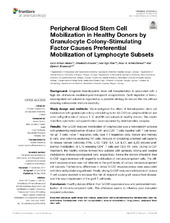Peripheral blood stem cell mobilization in healthy Donors by granulocyte colony-stimulating factor causes preferential mobilization of lymphocyte subsets
Melve, Guro Kristin; Ersvær, Elisabeth; Eide, Geir Egil; Kristoffersen, Einar Klæboe; Bruserud, Øystein
Peer reviewed, Journal article
Published version

Åpne
Permanent lenke
https://hdl.handle.net/1956/18227Utgivelsesdato
2018-05-02Metadata
Vis full innførselSamlinger
Originalversjon
https://doi.org/10.3389/fimmu.2018.00845Sammendrag
Background: Allogeneic hematopoietic stem cell transplantation is associated with a high risk of immune-mediated post-transplant complications. Graft depletion of immunocompetent cell subsets is regarded as a possible strategy to reduce this risk without reducing antileukemic immune reactivity. Study design and methods: We investigated the effect of hematopoietic stem cell mobilization with granulocyte colony-stimulating factor (G-CSF) on peripheral blood and stem cell graft levels of various T, B, and NK cell subsets in healthy donors. The results from flow cytometric cell quantification were examined by bioinformatics analyses. Results: The G-CSF-induced mobilization of lymphocytes was a non-random process with preferential mobilization of naïve CD4+ and CD8+ T cells together with T cell receptor αβ+ T cells, naïve T regulatory cells, type 1 T regulatory cells, mature and memory B cells, and cytokine-producing NK cells. Analysis of circulating lymphoid cell capacity to release various cytokines (IFNγ, IL10, TGFβ, IL4, IL9, IL17, and IL22) showed preferential mobilization of IL10 releasing CD4+ T cells and CD3−19− cells. During G-CSF treatment, the healthy donors formed two subsets with generally strong and weaker mobilization of immunocompetent cells, respectively; hence the donors differed in their G-CSF responsiveness with regard to mobilization of immunocompetent cells. The different responsiveness was not reflected in the graft levels of various immunocompetent cell subsets. Furthermore, differences in donor G-CSF responsiveness were associated with time until platelet engraftment. Finally, strong G-CSF-induced mobilization of various T cell subsets seemed to increase the risk of recipient acute graft versus host disease, and this was independent of the graft T cell levels. Conclusion: Healthy donors differ in their G-CSF responsiveness and preferential mobilization of immunocompetent cells. This difference seems to influence post-transplant recipient outcomes.
